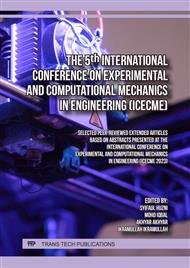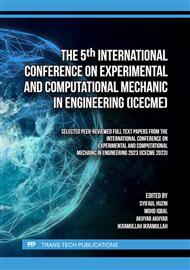p.3
p.15
p.23
p.35
p.43
p.57
Fracture Initiation and Development of Road Marker Subjected to Impact Loading
Abstract:
To meet the needs of road marking design and manufacturing, we ensure that our products meet the ergonomic aspects. strong, comfortable and esthetical. Strength, of course, has something to do with the strength of the material and the structure stability of the road marking products. Plastic road marking material are not strong enough to withstand large impacts. Concrete road markers are also heavy and difficult to transport and install because they require a mobile crane. Based on this, temporary road markings are made from concrete foam composites, the mass of which is lighter than concrete and stronger than plastic. The purpose of this study was to analyze the responses of road markers under impact loading produced by motor cycle. Ansys software is used as a numerical tool to simulate the stability of the structure of road markings. There are two-types of road marking models. Type 1 is a two-part in which both pole and base structure can be separately manufactured and assembled. Type 2 consists of one parts pole integrated with base structure of markers. The shape of the road markings is a hollow pole of 750 mm long with inner diameter of 50mm and outer diameter of 100mm. The base structure has 100mm thick and outer diameter of 300mm. To evaluate the responses of markers, a FEM based ANSYS software is used. Providing a motor cycle impact load of 100kg at 188 mm from base with a speed of 40km/h, the structural integrity of markers, that is, their response to static external loads is calculated. It is shown that the equivalent stress and stress in y-direction reach the maximum values when impacted on B location both for type 1 and type 2, respectively. For both cases the stress values are far below the ultimate tensile strength of the concrete foam materials. Thus, the impact load will not cause the failure of the road markers structure. In terms of production, type 2 road markers are easier to manufacture. It can be casted in two parts: base structure and pole. They are also practically easy for loading and unloading. Thus, for the continuation of research the type 2 road markers will be produced and tested in our research center. Keyword: Road Markers, Concrete Foam Composite, Motor Cycle Load. Software Ansys
Info:
Periodical:
Pages:
15-22
Citation:
Online since:
May 2025
Price:
Сopyright:
© 2025 Trans Tech Publications Ltd. All Rights Reserved
Share:
Citation:



